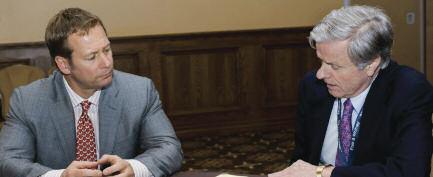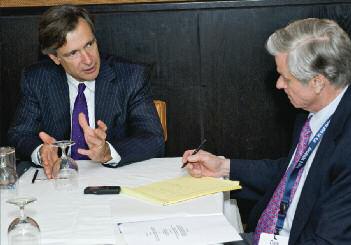PRATT & WHITNEY'S NEW FRONTIER WEST PALM BEACH, FL - The technology that launched the US space shuttle has found a new home on the energy block. |
 Jim Maser, President of Pratt & Whitney Rocketdyne with Dick Flanagan |
| In the ‘90’s, PWR had a demo solar
plant installed with the Los Angeles
Department of Water and Power and with
DOE on the Solar Two Project, a 10
megawatt pilot facility using a
Concentrated Solar Power Tower with
thermal storage. The CSP Tower technology
uses thousands of articulating mirrors,
tracking the sun and reflecting solar energy
to a receiver mounted on a 600 foot tall
tower. Liquefied molten salt is circulated
into the receiver, where it is heated to
about 1,000 degrees Fahrenheit, than
stored in a large insulated tank. Molten
salt can be stored for days with little heat
loss. PWR provided the worldwide exclusive
license to Solar Reserve. “We currently have no ownership
interest in Solar Reserve, but we are
supporting them to get a DOE loan
guaranteed,” Maser said. “We have an
exclusive source of supply and they’ve
provided additional funding for engineering
activity.” |
|
| World-Gen asked Maser why PWR
didn’t integrate the new niche energy market
products into Pratt & Whitney Power
Systems. “First of all, our assessment of
the solar market is relatively conservative
and, having the entire plan under PWPS,
presented a relatively high amount of risk,”
Maser answered. “As a team we decided
PWPS should back out of this. With other
technology, I think that’s still a potential
model.” PWPS World-Gen also interviewed Peter Christman, President of Pratt & Whitney Power Systems on P&W’s Media Day in Florida. The PWPS portfolio presently includes the FT8 SWIFTPAC, Organic Rankine Cycle and Clipper Windpower. “The FT8 can be twin-packed for 60 megawatts,” Christman said. “A new FT4000, the next generation industrial gas turbine, will be announced later this year.” PWPS has more than 2,000 industrial gas turbines installed in over 50 countries worldwide. |
PRATT&WHITNEY POWER SYSTEMS  Peter Christman, President, Pratt & Whitney's Power Systems with Dick Flanagan |
| “We had taken over ORC technology
incubated at UTC Power called PureCycle
Power System unit, using the ORC cycle,
which is about a 250 kW machine. We
liked the space for geothermal, biomass,
and industrial waste heat processes,”
Christman underscored. “We decided to
make a majority investment in Turboden,
an Italian manufacturer of ORC systems for
over 30 years. The strategy behind the
acquisition was they had a number one
market position in Europe and we could
leverage that position to the rest of the
world.” PWPS offers a full range of maintenance, overhaul, repair and spare parts for other OEM’S and has offices in Russia and India. “In Russia, we have 10 people in the Moscow office and 20 service technicians in other parts of Russia,” Christman said. “They are charted to sell our entire portfolio portfolio of products but we’ve gotten good traction on both OEM equipment and aftermarket.” In India, the Delhi office provides repair services and repairs virtually any of the frame types by Siemens, GE and others. “So as gas turbine technology continues to get penetration in the India market, the Indian market is looking for alternatives to the OEM,” he said. “Right now the work gets sent out of the country. We have a repair shop in Singapore that’s where we do the work. If we get to the point where there’s sufficient in-country volume, we would look to invest.” CLIPPER ACQUISITION PWPS acquired the balance of Clipper shares in December, 2010. “We have a facility in Cedar Rapids, Iowa and Denver, which is really a nucleus for field service support,” he said. About 500 Liberty turbines were sold, and another 250 will be installed this year.” World-Gen asked him to size up the market. “I think it’s a market that’s evolving fairly rapidly, although the U.S. market has been tapped down the last year and a half or so, markets outside of North America continue to grow at a fairly robust pace. There’s competition in this space, a lot of people in it, but we believe ultimately that there’s some technology that resides within UTC where we can differentiate ourselves from others. And that’s where we intend to go”. Clipper announced a program to do a 10 megawatt turbine for offshore application in the U.K. Since UTC acquired the business, that program is currently under review. Christman said a decision would be reached within 90 days about its future. Pratt & Whitney is a United Technologies Company, based in East Hartford, CT. |
|
|
|
|
|
|
